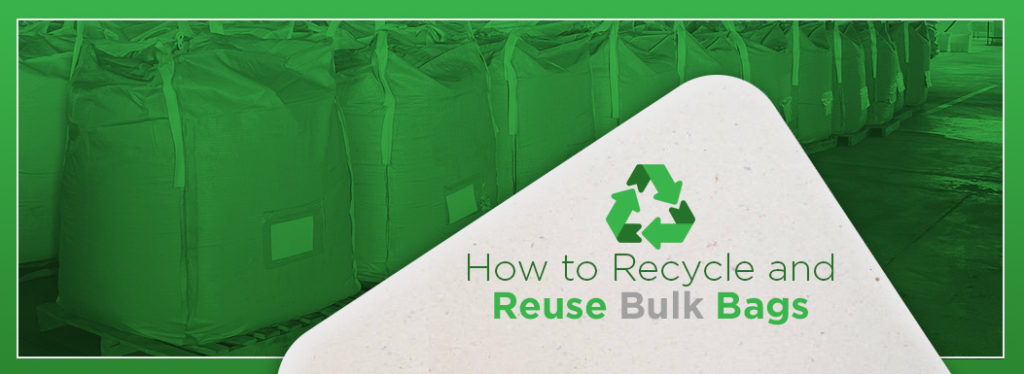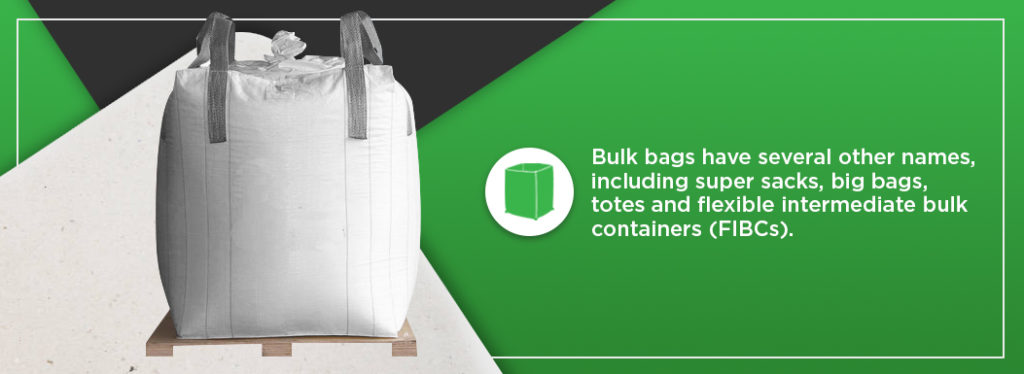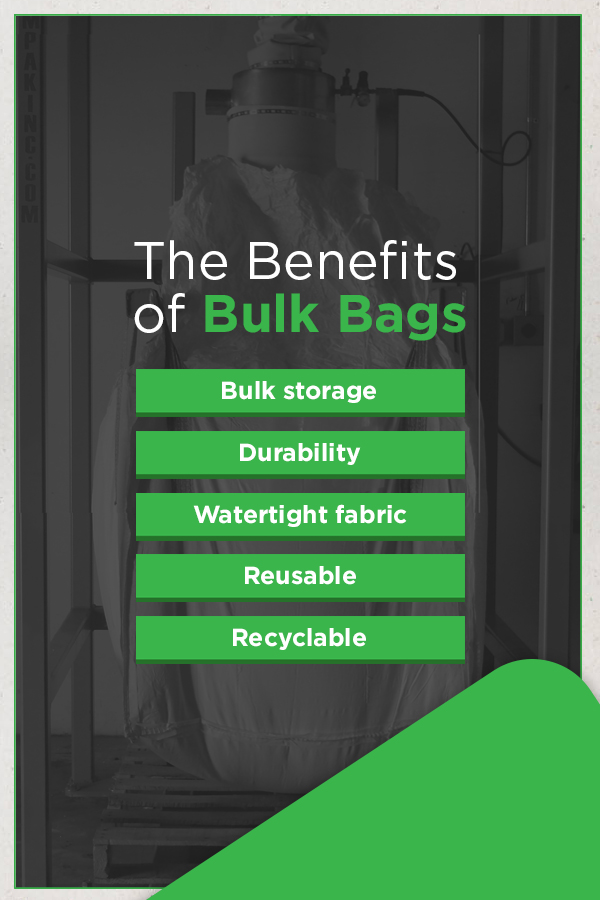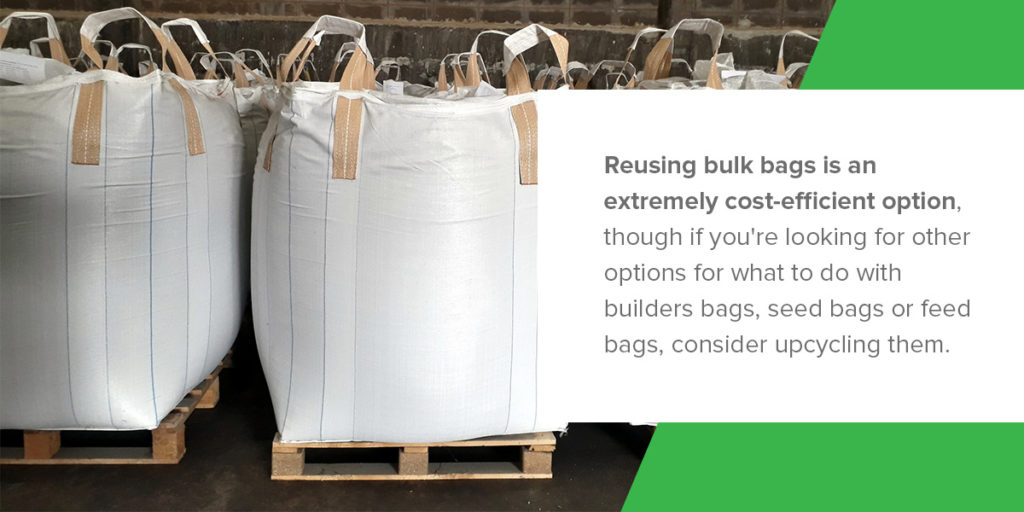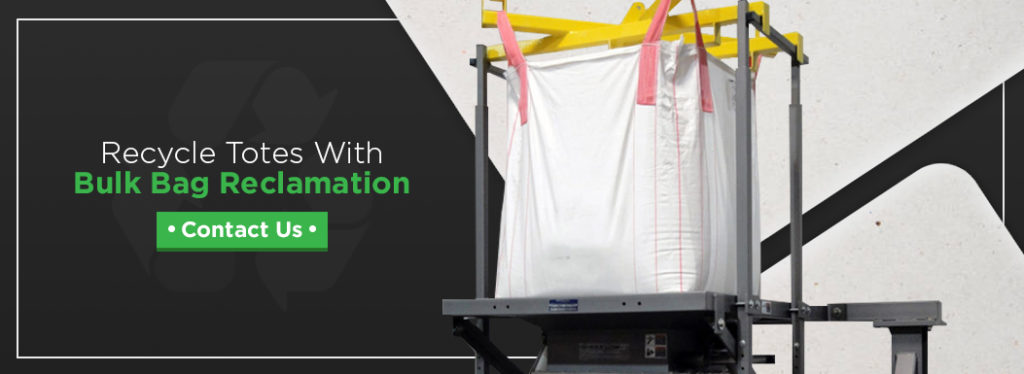How to Recycle and Reuse Bulk Bags
Using bulk bags in your company’s day-to-day processes can simplify the way you handle large quantities of either waste or product. Whether you need them to withstand shipping or storage, these bags are made to take on tough jobs with ease. And one of their best attributes is that they’ll serve your needs for longer than a single use. However, not every company that uses bulk bags knows that they are recyclable.
This guide will take you through everything you need to know about reusing and recycling your bulk bags.
What Are Bulk Bags?
Bulk bags have several other names, including super sacks, big bags, totes and flexible intermediate bulk containers (FIBCs). They are made of flexible material, typically strands of polypropylene (PP) woven into a fabric. Because they’re made of a durable PP mesh, these bags are versatile and hold up for long periods of use. They’re perfect for storing and transporting large quantities of goods. Many different industries use bulk bags, including animal nutrition, agriculture, food processing, chemical industries, construction, mining and more.
Depending on the dimensions, intended handling methods, discharging, filling and barrier elements of each type of FIBC, they can easily hold from 1,000 to 4,000 pounds of material. In some cases, the bags are customizable and fitted to customer needs. The totes will withstand wear from mechanical handling by way of cranes, forklift trucks and hoists without requiring any secondary packaging or protection.
Shape differentiates the four basic FIBC designs:
- U-Panel: In this style, a single panel forms two of the opposing sides and the bottom of the bag, effectively giving the tote a U-shaped structure and strength.
- Four-Panel: The body of a four-panel bag is shaped like it sounds. It consists of four pieces of fabric, sewn together to create an almost rectangular bag.
- Circular: Also known as a tubular bag, the circular design has no vertical seams, unlike the panel types. Instead, weaving machines create the fabric on a circular loom. Then, the material is measured and cut to the proper heights for different bag capacities.
- Baffle: While not referencing the overall shape of the tote itself, baffle bags are discernible by the pieces of fabric located in the corners of some tubular and four-panel bags. The sewn-in additions help to create squareness, improve the general appearance and increase the stability of the tote. They encourage better efficiency in shipping and storage spaces.
Depending on your intended uses for the bags, you can choose the shape that best fits your needs. Regardless of your choice, each design serves as a cost-effective and environmentally friendly alternative to other bulk storage and shipping containers. You’ll gain many advantages from using and reusing them in your business.
The Benefits of Bulk Bags
Whether you’re considering several container options for your company or need a better alternative to your current methods, bulk bags are a great option. Super sacks can provide you with many benefits other storage solutions can’t deliver. On top of that, they’re relatively cost-effective, so you won’t need to worry about breaking the bank. Some of the benefits of FIBCs include:
- Bulk storage: With bulk bags, you can store large quantities of materials at once. Some of the bags can hold up to 4,000 pounds or more, making it easy to consolidate your stock into only a few containers. Using a lift truck or similar piece of machinery, you can easily fill, move and place bulk amounts of material.
- Durability: Modern super sacks are made of a woven mesh fabric of PP strands. This plastic-based fabric is resistant to mold and mildew, as it doesn’t trap any water. It also has decent resistance to heat exposure, as it’s able to shrink and stretch without damage. The weave pattern creates a stronger fabric than non-woven material, and the overlapping strands increase the strength of the bag as a whole. For purposes that require even more heavy-duty containers, there are also more expensive variants made of PVC-coated polyester fabric. The seams of these bags are welded, keeping them watertight and enabling easier repairs.
- Watertight fabric: With watertight options available, you’ll be able to store and ship materials that need to stay dry without worrying about mold or mildew growth. Even if your storage space gets humid or takes on water in a storm, FIBCs can keep your materials safe from water damage. They’ll also have the same protection in shipping, ensuring that your stock stays in its perfect condition.
- Reusable: Since PP bags are so durable, you can easily repurpose them once they’re finished with a job. As long as you take care of the totes and clean them correctly in between uses, you can make them last for several rounds of shipping or storage. Reusable containers mean lower storage costs for your company over time and a consistent supply of shipping packaging for bulk units.
- Recyclable: Once the bags have served their lifespan and can no longer be safely reused, you can recycle them. The material will go towards making new totes and other PP-based products. By recycling the bags, tote manufacturers can reduce prices, as they don’t have to use 100% virgin materials for every unit. Also, recycling the materials keeps more plastics out of landfills and the environment, and reusing the materials in the production of new bags means lower energy expenditure. So, these totes are a win-win for you and the environment.
With so many benefits to consider, using bulk storage bags is a natural choice. Your company will be able to safely store and ship bulk units without worrying about purchasing new packaging or sustaining damage over time. Even when the bags need retiring, the recycling option is a plus for you and the planet. Reusing and recycling the bags are both relatively straightforward processes, keeping your operations running smoothly without hitting any container snags.
How to Reuse Bulk Bags
One of the best features of bulk bags is that many of the modern styles and materials make them fit for reuse. This means you can store or ship several loads of goods, empty the bags when you’re finished and either clean and use them again or send them to a recycling company for the material to be reclaimed.
If you want to reuse your bags and get the most value for the initial costs, you have to make sure to choose the right types in the first place. FIBCs have safety ratings that determine whether or not they are safe for reuse. The safety factor rating means the totes will hold up x number of times the SWL as long as you care for them properly.
To safely and properly reuse bulk bags, you should adhere to the following process, as suggested by the Flexible Intermediate Bulk Container Association (FIBCA):
- Reject: Carefully inspecting your bags should be the first step in considering any of them for reuse. As you look through them, check for visible damages and wear, anything that might make repurposing the bag an unsafe choice. Reject any tote that doesn’t fit the safety standards. Some guidelines for rejecting bags include observable damage on the lift straps, outside contamination, dampness or growth of mold or mildew, embedded wood splinters and unreadable printing on the outside.
- Clean: Once you’ve weeded out any unusable bags, you need to shift your focus to preparing the totes you plan to repurpose. The first step in preparation is cleaning. Make sure there is no residual matter in the bag and replace the liner if it has one. Also, ensure the statically held dust totals less than four ounces.
- Recondition: Reconditioning involves ensuring your bulk bags will be able to function the same way. Replace the web ties, labels, tickets and cord-locks as necessary to keep the totes in top-performing condition. Not only will this help ensure safer reuse, but it will extend the lifespan of the FIBC as a whole.
- Track: As you go through the process of obtaining, using, reusing and retiring bulk bags, you need to keep a record. Manufacturers and stock managers should note the origin of each tote, products it has held, duration of time in use and the number of reuses it has endured. Update the records each time you go to reuse a bulk bag.
- Test: As a safety precaution, it’s crucial to conduct randomized top lift testing. Deciding on the frequency and quantity of these tests is up to the manufacturer or manager and should be based on the uses and circumstances presented in their individualized situation.
The system of safely reviewing, monitoring and requalifying bags for reuse is referred to as a closed-loop system. Using these guidelines is the best way to ensure safety and proper use of your bulk bags. If you have to reject totes during the process, the next best step is to recycle them.
Can You Upcycle Bulk Bags?
Reusing bulk bags is an extremely cost-efficient option, though if you’re looking for other options for what to do with builders bags, seed bags or feed bags, consider upcycling them. Upcycling involves reusing an object or material to create a new, potentially more valuable item.
Whether your company is looking for ways to reuse the bulk bags or you’re reusing them for personal use, upcycling allows you to use the bags for different purposes, rather than just holding, storing or transporting products. For example, if you ordered animal feed for your farm and it came in bulk bags, consider how you could upcycle the bag into something new:
- Compost bags: If you have a compost pile or want to start one, consider upcycling your bulk bags into compost bags. To start your new compost bag, clean out the bag to remove any remnants of what was originally in the super sack. Fill the bottom of the bag with sticks then soil or old compost. Either will work, as long as there are lots of worms in it. As you add compostable items, be sure to stir up the contents occasionally. After some time, you’ll have your own compost.
- Raised garden bags: Raised garden beds are a great alternative to digging up the ground and tending to a plot of land. If you’re looking for an easy way to grow a few fruits or vegetables, upcycle used bulk bags into raised garden beds — or bags. Fill the bottom with stones or another draining material, then add your soil or compost and plant your crop.
- Weed suppression: If you do have a garden or flower beds, consider using your bulk bags in place of weed suppression plastic. Weed suppression plastic is used as a base layer over the ground in gardens or flower beds to prevent weeds from sprouting. Rather than purchasing new sheets of plastic, turn your bulk bags into weed suppressors.
- Tarps: While a single bulk bag won’t cover anything big, you can create an upcycled tarp out of multiple bulk bags. Attach builders bags to each other to create a giant blanket. Bulk bags work well as a tarp or cover because they’re water-resistant and block out debris. Use your upcycled tarp to cover equipment, furniture or other items you may store outdoors or want to protect from dirt and other elements.
Bulk Bag Recycling
Most modern FIBCs start as virgin PP plastic, made into woven fabric, then shaped or sewn to form bags. Because they are made almost entirely of plastic, the totes are fully recyclable and reusable. Not only do they last through multiple uses and environmental wear, but the PP material can be processed again and again without losing much structural integrity.
Once you can no longer reuse the totes, you can recycle bulk bags by sending them to the proper facility with knowledge on how to dispose of bulk bags. The super sack recycling process includes several phases:
- Collection: As with most recycling processes, the first stage is the collection of recyclable materials. The most cost-effective and easiest method of submitting bulk bags is in compacted bales. There are three grades by which the bags should be organized — namely, Grade A, B and C. Grade A bags include those that are clean and all white, except for colored stitching and handles. Grade B is classified as bags that are noticeably dirty but still mostly white with a little coloring. Grade C is all of the excessively dirty or colorful bags.
- Sorting and cleaning: Since bulk totes serve a wide range of industries and uses, they need to be sorted into groups and thoroughly cleaned based on what they contained. Bulk bags are often used to hold materials that range from sand to fertilizer to hazardous chemicals, so proper cleaning is essential. During this phase, the recycling facility will also remove all zips and buttons.
- Shredding: Once they have been cleaned and prepped, the bags go through a shredder, reducing them to small flakes of material. This phase makes the rest of the processes more manageable.
- Separation: During this stage of the recycling process, machines separate the shredded bag material and sort it based on color, size, shape, melting point or light absorption. They also sort any impurities and contaminants out of the polymers.
- Compounding: The final phase of the process is compounding, where the polymers are recombined. Extruders melt down the ground-up material at a high temperature of 240 degrees Celsius, creating pellets or granules of the plastic. These pellets are used in new products, such as clothing and playground equipment. To strengthen the mix, recyclers add virgin PP, sometimes totaling up to 50% of the blend.
While it is a technical process, experienced and equipped bulk bag recyclers will be able to complete it with relative ease. Since PP plastics are safe to recycle and don’t lose their properties during the process, they can be repurposed for new products time and time again.
The Importance of Recycling Woven Polypropylene Bags
Polypropylene plastic packaging is one of the most common plastics. It’s able to be melted down and repurposed over and over, though much of the material fails to be recycled. An extremely small amount of PP is recycled — only about 1% makes it to recycling centers worldwide — and the majority of PP ends up in landfills. Leaving polypropylene to slowly decompose releases hazardous chemicals into the surrounding environment, causing major environmental issues.
Reusing, upcycling and recycling bulk bags helps keep plastics and dangerous chemicals out of landfills and puts them back in circulation to manufacture new products. Recycling woven PP bags also benefits the environment in other ways. Significant amounts of energy are consumed when PP products are manufactured from virgin materials. Recycling PP and blending it with other materials reduces the need for virgin plastics and helps reduces energy use by up to 88%.
Using smaller amounts of virgin materials also helps conserve finite resources like propane gas and oil, which are used to manufacture polypropylene plastics. Giving bulk bags a second life reduces manufacturing environmental impacts, preserves resources and reduces the amount of PP plastics entering landfills.
Recycle Totes With Bulk Bag Reclamation
If you’re wondering where to recycle polypropylene bags, consider Bulk Bag Reclamation. At Bulk Bag Reclamation, we care about keeping super sacks out of landfills and on the market. Our company is more than just a bulk bag recycling facility. We offer a full inventory of reconditioned totes, giving you access to high-quality, cost-efficient options for purchases.
We’ll also purchase your lightly used bags and offer them to our customers. All of our refurbished bags are free from hazardous materials, cleaned to residue standards, repaired and thoroughly inspected before selling. You can trust us for top-quality refurbished containers — we even offer the opportunity to review two free samples before you commit to a purchase.
Help keep bulk bags out of landfills — request a quote today or contact us for more information.

